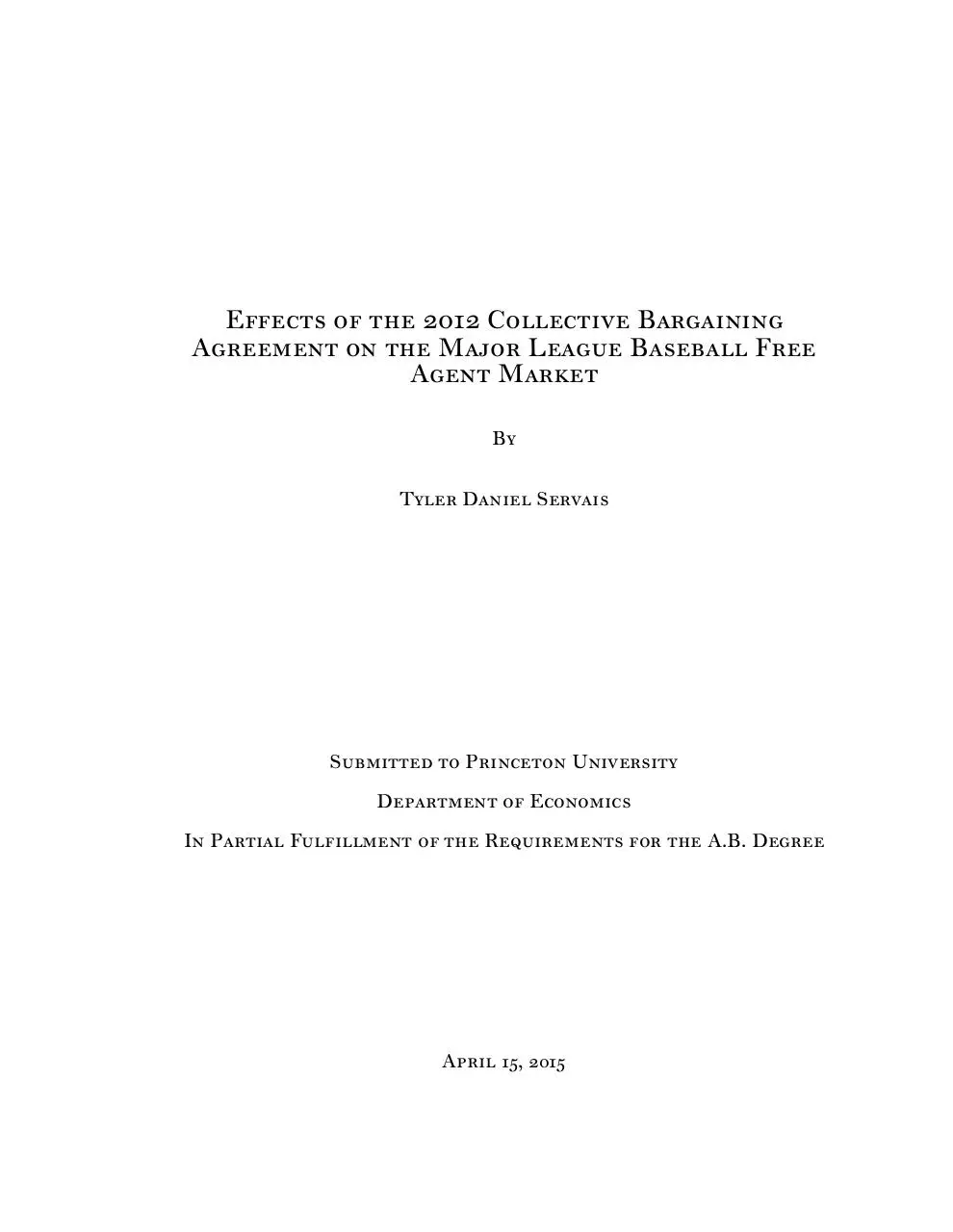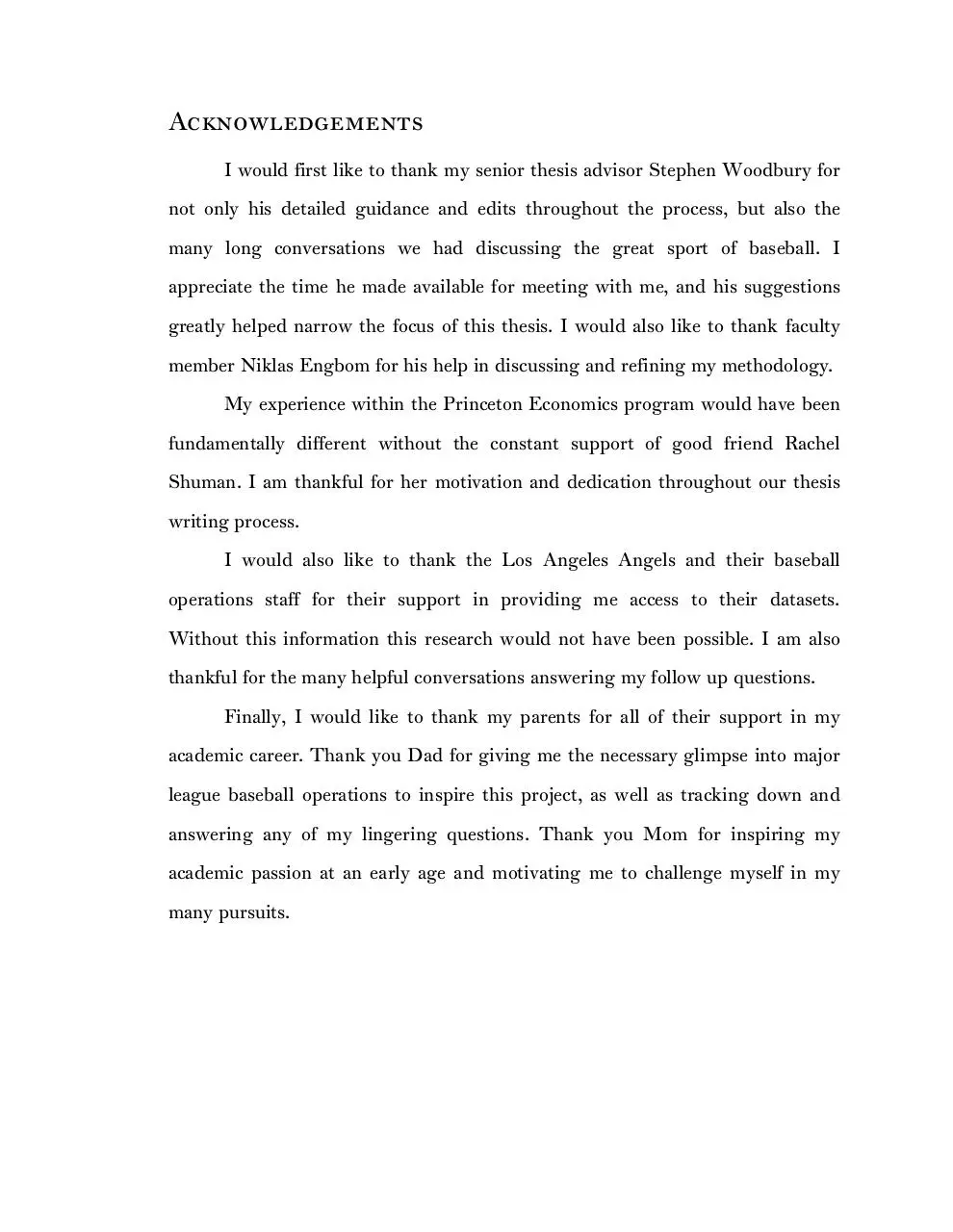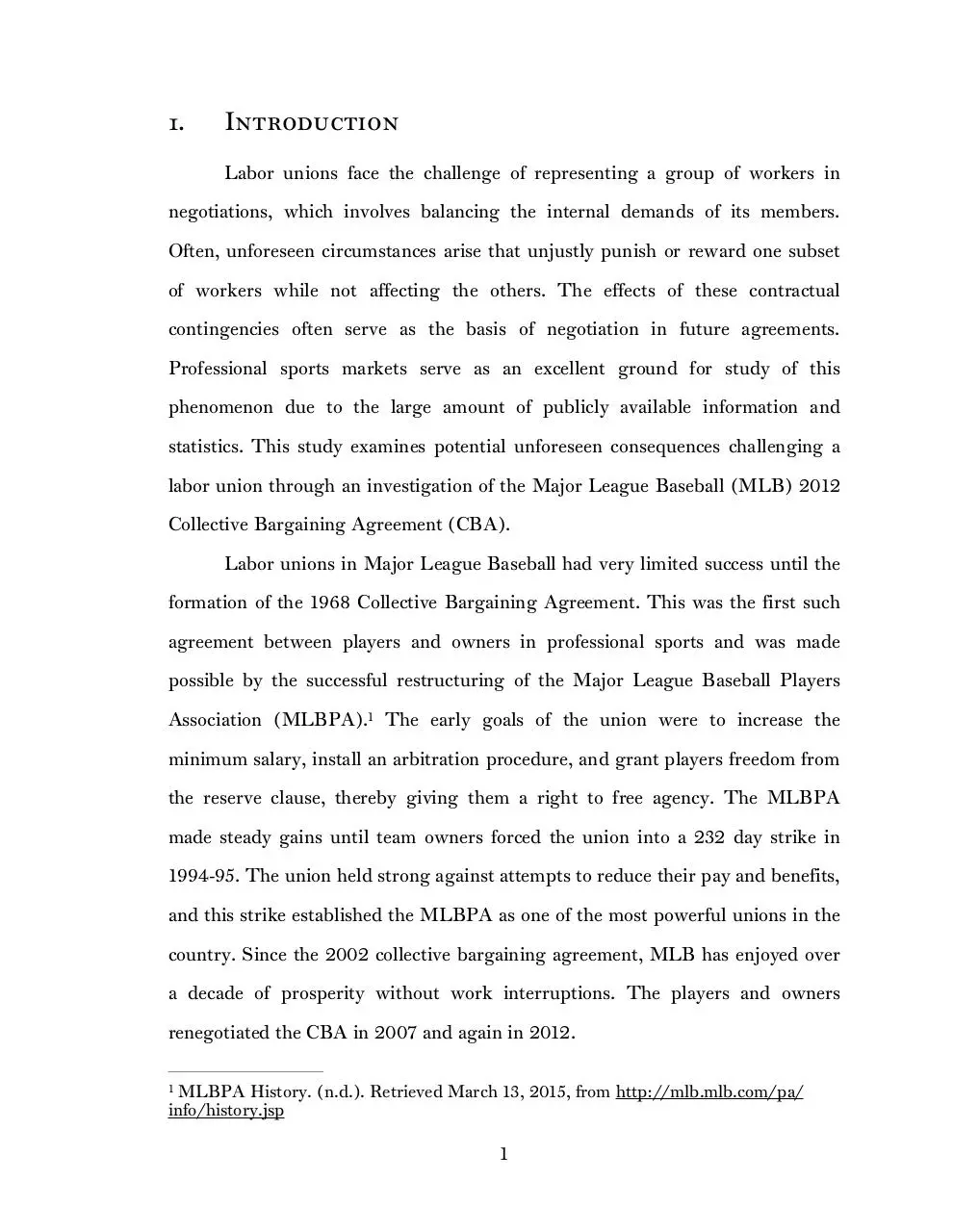Final Senior Thesis (PDF)
File information
Title: Final Senior Thesis
This PDF 1.3 document has been generated by Pages / Mac OS X 10.10.2 Quartz PDFContext, and has been sent on pdf-archive.com on 04/08/2016 at 18:29, from IP address 50.135.x.x.
The current document download page has been viewed 668 times.
File size: 444.19 KB (71 pages).
Privacy: public file





File preview
Effects of the 2012 Collective Bargaining
Agreement on the Major League Baseball Free
Agent Market
By
Tyler Daniel Servais
Submitted to Princeton University
Department of Economics
In Partial Fulfillment of the Requirements for the A.B. Degree
April 15, 2015
Acknowledgements
I would first like to thank my senior thesis advisor Stephen Woodbury for
not only his detailed guidance and edits throughout the process, but also the
many long conversations we had discussing the great sport of baseball. I
appreciate the time he made available for meeting with me, and his suggestions
greatly helped narrow the focus of this thesis. I would also like to thank faculty
member Niklas Engbom for his help in discussing and refining my methodology.
My experience within the Princeton Economics program would have been
fundamentally different without the constant support of good friend Rachel
Shuman. I am thankful for her motivation and dedication throughout our thesis
writing process.
I would also like to thank the Los Angeles Angels and their baseball
operations staff for their support in providing me access to their datasets.
Without this information this research would not have been possible. I am also
thankful for the many helpful conversations answering my follow up questions.
Finally, I would like to thank my parents for all of their support in my
academic career. Thank you Dad for giving me the necessary glimpse into major
league baseball operations to inspire this project, as well as tracking down and
answering any of my lingering questions. Thank you Mom for inspiring my
academic passion at an early age and motivating me to challenge myself in my
many pursuits.
Abstract
The introduction of the 2012 Major League Baseball (MLB) Collective
Bargaining Agreement (CBA) made substantial changes to the first-year player
draft and the free agent market. Using a sample of 1,249 2008-2015 free agents,
this study investigates the extent to which contract outcomes of top tier players
have been impacted by the replacement of the Elias Sports Bureau type
designations with the qualifying offer system. This study finds evidence
suggesting that qualifying offer type players are now receiving worse contract
outcomes relative to other free agents in each given year. Additionally,
counterintuitive evidence suggests that players that would have previously been
designated as top free agents are also receiving worse contract outcomes relative
to other players following the new CBA. The direction of these results is not
sensitive to measure of contract outcome (guaranteed amount or average annual
value), however the level of statistical significance is sensitive to such measures.
Future research on this subject could benefit from additional years of analysis, as
well as stronger prediction models.
Table of Contents
1.
Introduction
1
1.1. The First-Year Player Draft
3
1.2. The Free Agent Market
6
2.
Literature Review
10
3.
Data
14
4.
3.1. Generic and Contract Variables
15
3.2. Player Performance Variables
18
3.2.1. Offensive Metrics
18
3.2.2. Defensive Metrics
21
3.2.3. Pitching Metrics
23
3.2.4. Total Player Contribution Metrics
27
Qualifying Offers
4.1. Analysis of Qualifying Differences
28
4.1.1. Calculation of Qualifying Difference
28
4.1.2. Results of Qualifying Difference
30
4.2. Analysis of Qualifying Offer Type Players
31
4.2.1. Modeling the Probability of a Qualifying Offer
31
4.2.2. Estimates of the Model
34
4.2.3. Contract Outcomes of Qualifying Offer Type Players
35
4.2.4. Comparison of Actual Qualifying Offers with Counterfactuals
40
4.3. Discussion
5.
28
Elias Sports Bureau Type A Designations
5.1. Methodology
42
45
45
5.1.1. Modeling Type A Free Agents
45
5.1.2. Comparison of Type A Free Agents
50
5.2. Empirical Results
51
5.2.1. Modeling Type A Free Agents
51
5.2.2. Comparison of Type A Free Agents
57
5.3. Discussion
59
6.
Conclusion
61
7.
Bibliography
65
1.
Introduction
Labor unions face the challenge of representing a group of workers in
negotiations, which involves balancing the internal demands of its members.
Often, unforeseen circumstances arise that unjustly punish or reward one subset
of workers while not affecting the others. The effects of these contractual
contingencies often serve as the basis of negotiation in future agreements.
Professional sports markets serve as an excellent ground for study of this
phenomenon due to the large amount of publicly available information and
statistics. This study examines potential unforeseen consequences challenging a
labor union through an investigation of the Major League Baseball (MLB) 2012
Collective Bargaining Agreement (CBA).
Labor unions in Major League Baseball had very limited success until the
formation of the 1968 Collective Bargaining Agreement. This was the first such
agreement between players and owners in professional sports and was made
possible by the successful restructuring of the Major League Baseball Players
Association (MLBPA).1 The early goals of the union were to increase the
minimum salary, install an arbitration procedure, and grant players freedom from
the reserve clause, thereby giving them a right to free agency. The MLBPA
made steady gains until team owners forced the union into a 232 day strike in
1994-95. The union held strong against attempts to reduce their pay and benefits,
and this strike established the MLBPA as one of the most powerful unions in the
country. Since the 2002 collective bargaining agreement, MLB has enjoyed over
a decade of prosperity without work interruptions. The players and owners
renegotiated the CBA in 2007 and again in 2012.
1
MLBPA History. (n.d.). Retrieved March 13, 2015, from http://mlb.mlb.com/pa/
info/history.jsp
1
In recent CBA negotiations the biggest concerns have surrounded the
increasing cost of player acquisition. Professional baseball teams acquire new
talent primarily through three methods. The principal method is the first-year
player draft. This allows teams to participate in a selection process that includes
all eligible High School and College players in the United States, Canada, and
Puerto Rico. The selecting team gains sole negotiating rights with the player
until a set deadline. The second method of talent acquisition is the free agency
market. This allows teams to sign players whose previous contract has expired.
The final method of acquiring new players is the international signings market.
Unlike the draft, in this market all teams have the ability to compete for top tier
prospects by offering large bonuses. Success is largely determined by scouting,
negotiation tactics, and ability to pay. These three methods are the lifeblood of
talent acquisition in professional baseball.
Each of the three methods of talent acquisition regularly comes under
scrutiny by the MLB owners due to the rising cost of signing bonuses. Over the
past decade the inflation-adjusted amount paid to players has increased
dramatically (an average salary increase of over 44% from 2002-2012)2 due to a
superstar effect in the demand for the highest level of talent. However, team
revenues have experienced an even greater increase over the same time period.
Nonetheless, owners seek to maximize their profits by keeping the cost of players
as low as they can. This generally creates a tension between the players union
and the owners during each round of CBA negotiations.
It is important to recognize that the MLBPA represents only players on
the major league 40 man roster. Therefore, the union’s main priority in
2
MLB Salaries. (n.d.). Retrieved April 9, 2015, from http://www.cbssports.com/mlb/
salaries/avgsalaries
2
negotiations has been keeping MLB salaries and free agency bonuses high, while
paying little attention to the financial well-being of players coming from the draft
or international markets. Thus, at the end of 2011, the MLBPA and owners
association were able to negotiate a collective bargaining agreement that would
overhaul team spending in the draft and the international markets. Structural
changes linking free agency to the draft were instituted as well. The next section
of this introduction details the changes to these two methods of player
acquisition.
1.1. The First-Year Player Draft
As described in Has the 2012 Major League Baseball collective bargaining
agreement reduced the probability that drafted players sign a professional
contract?,3 each summer, all 30 Major League Baseball teams seek to add talent
to their organizations through the first-year player draft. Since the first draft in
1965,4 there have been continual changes and tweaks to the structure of the draft,
most recently in 2007 and 2012. Leading up to the changes in 2012, the draft
consisted of 50 rounds, and teams were ordered to draft based on their finish
from the previous season (with the worst team receiving the number one overall
pick). The picks were not tradable, and although MLB suggested signing
bonuses for each pick of each round, teams were able to spend what they wanted.
This led to rapidly increasing signing bonuses each year. Wanting to combat this
trend, the owners, along with the MLBPA, agreed to numerous changes in the
2012 collective bargaining agreement. The draft was reduced from 50 to 40
3
Servais, T. (2014). Has the 2012 Major League Baseball collective bargaining
agreement reduced the probability that drafted players sign a professional contract?
4
First-Year Player Draft. (n.d.). Retrieved March 13, 2015, from http://mlb.mlb.com/
mlb/history/draft/
3
rounds, and team bonus pools were created. Each pick in the first ten rounds now
has an assigned slot value, and the sum of these values is a team’s overall bonus
pool. In 2014 these team bonus pools ranged from 2.2-13.3 million dollars.5 The
slot values decreased with each pick in the draft and in 2014 ranged from 7.92
million for the number 1 overall pick, to $137,600 for the picks at the end of the
10th round.6 For every pick after the 10th round, teams can spend up to
$100,000 to sign a player without it counting against their total bonus pool.
If a team chooses to spend more than its allotted bonus pool value, then it
must pay a luxury tax starting with a 75% tax on the first 0-5% over the team’s
specified bonus pool. If a team goes 5-10% over their bonus pool, the tax will rise
to 100% and it will lose its first-round draft pick in the next year. If a team goes
more than 15% over, it could lose its following first-round draft picks for the next
two seasons.7 The luxury tax implies that the bonus pools are not completely
binding; however, their violation triggers penalties. These rule changes, aimed at
reducing the total amount spent in each year’s draft, could potentially have an
impact on draft strategy, and the effects have yet to be fully accounted for.
Players are eligible for the draft if they are a resident of the USA, Canada,
or US territory, have graduated high school, attend a junior college, are juniors
or seniors at four year colleges, or have turned 21.8 Drafted players and teams
5
Cooper, J. (2014, April 2). 2014 Draft: Signing Bonus Allotments By Team. Retrieved
March 13, 2015, from http://www.baseballamerica.com/draft/2014-draft-signingbonus-allotments-by-team/
6
2014 Draft: Assigned Pick Values For Top 10 Rounds - BaseballAmerica.com. (2014,
April 2). Retrieved March 13, 2015, from http://www.baseballamerica.com/draft/2014draft-assigned-pick-values-for-top-10-rounds/
7
MLB players, owners sign agreement. (2011, November 23). Retrieved March 13,
2015, from http://espn.go.com/mlb/story/_/id/7269300/major-league-baseballplayers-owners-sign-new-labor-agreement
8
First-Year Player Draft FAQ. (n.d.). Retrieved March 13, 2015, from http://
mlb.mlb.com/mlb/draftday/faq.jsp
4
have until July 12th-18th to reach a contract agreement.9 If no deal is reached,
then the player is able to go or return to college. If the pick was in the top 3
rounds and the team offered the player at least 40% of the slot value, then the
team receives a compensation pick of similar value in the next year’s draft.10 This
gives teams more leverage in negotiating with top prospects. Additionally, before
the 2012 CBA teams could offer select players major league contracts as part of
the negotiation. However, under the new rules all players are limited to signing
minor league deals. In the past, the lack of signing bonus structure had led to a
negotiation-friendly environment; however, with a stronger emphasis placed on
sticking to slot values there is now less flexibility.11
The changes to the draft have placed a cap on the total amount that teams
can spend on signing draftees. This cap is directly related to the ordered draft
picks the team is assigned. If the team is forced to give up a top draft pick (as is
the case when signing certain free agents) then they are also giving up the right
to use that amount of money signing any players. For example, a team may have a
total bonus pool of over $14 million, yet if they are forced to give up a first round
draft pick that pool shrinks to under $13 million.12 I hypothesize that the value of
this first round draft pick could be calculated into team decisions to sign free
agent players. Thus an understanding of the interaction between the draft and
the free agent market is crucial in this study.
9
Before the 2012 CBA the deadline was August 15th
10
Before the 2012 CBA teams received a compensation pick only for unsigned selections
in the first round
11
Servais, T. (2014). Has the 2012 Major League Baseball collective bargaining
agreement reduced the probability that drafted players sign a professional contract?
12
2014 Draft: Assigned Pick Values For Top 10 Rounds - BaseballAmerica.com. (2014,
April 2). Retrieved March 27, 2015, from http://www.baseballamerica.com/draft/2014draft-assigned-pick-values-for-top-10-rounds/
5
Download Final Senior Thesis
Final Senior Thesis.pdf (PDF, 444.19 KB)
Download PDF
Share this file on social networks
Link to this page
Permanent link
Use the permanent link to the download page to share your document on Facebook, Twitter, LinkedIn, or directly with a contact by e-Mail, Messenger, Whatsapp, Line..
Short link
Use the short link to share your document on Twitter or by text message (SMS)
HTML Code
Copy the following HTML code to share your document on a Website or Blog
QR Code to this page

This file has been shared publicly by a user of PDF Archive.
Document ID: 0000409533.